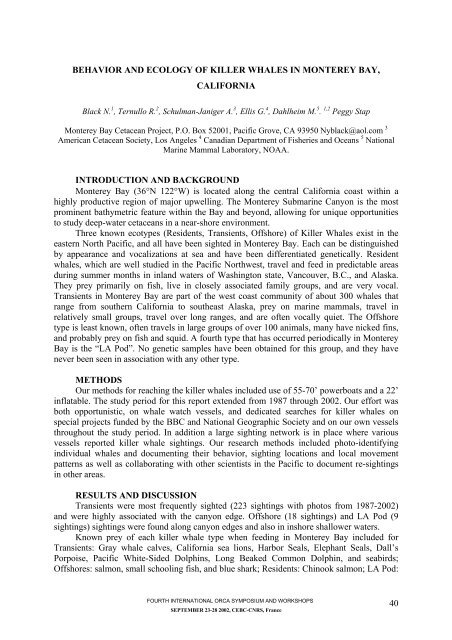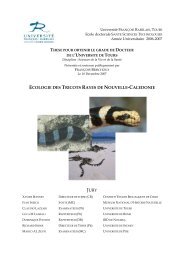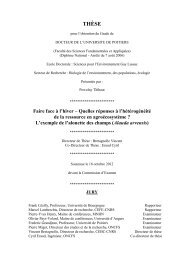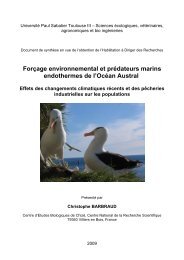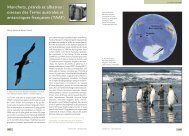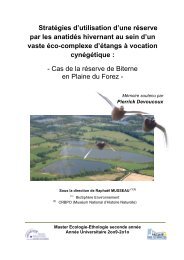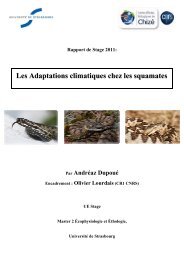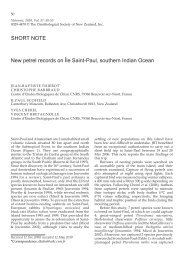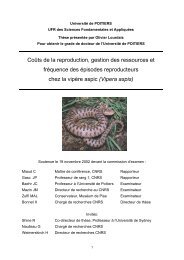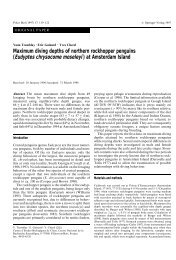Fourth International Orca Symposium and Workshop - CEBC - CNRS
Fourth International Orca Symposium and Workshop - CEBC - CNRS
Fourth International Orca Symposium and Workshop - CEBC - CNRS
You also want an ePaper? Increase the reach of your titles
YUMPU automatically turns print PDFs into web optimized ePapers that Google loves.
BEHAVIOR AND ECOLOGY OF KILLER WHALES IN MONTEREY BAY,<br />
CALIFORNIA<br />
Black N. 1 , Ternullo R. 2 , Schulman-Janiger A. 3 , Ellis G. 4 , Dahlheim M. 5 . 1,2 Peggy Stap<br />
Monterey Bay Cetacean Project, P.O. Box 52001, Pacific Grove, CA 93950 Nyblack@aol.com 3<br />
American Cetacean Society, Los Angeles 4 Canadian Department of Fisheries <strong>and</strong> Oceans 5 National<br />
Marine Mammal Laboratory, NOAA.<br />
INTRODUCTION AND BACKGROUND<br />
Monterey Bay (36°N 122°W) is located along the central California coast within a<br />
highly productive region of major upwelling. The Monterey Submarine Canyon is the most<br />
prominent bathymetric feature within the Bay <strong>and</strong> beyond, allowing for unique opportunities<br />
to study deep-water cetaceans in a near-shore environment.<br />
Three known ecotypes (Residents, Transients, Offshore) of Killer Whales exist in the<br />
eastern North Pacific, <strong>and</strong> all have been sighted in Monterey Bay. Each can be distinguished<br />
by appearance <strong>and</strong> vocalizations at sea <strong>and</strong> have been differentiated genetically. Resident<br />
whales, which are well studied in the Pacific Northwest, travel <strong>and</strong> feed in predictable areas<br />
during summer months in inl<strong>and</strong> waters of Washington state, Vancouver, B.C., <strong>and</strong> Alaska.<br />
They prey primarily on fish, live in closely associated family groups, <strong>and</strong> are very vocal.<br />
Transients in Monterey Bay are part of the west coast community of about 300 whales that<br />
range from southern California to southeast Alaska, prey on marine mammals, travel in<br />
relatively small groups, travel over long ranges, <strong>and</strong> are often vocally quiet. The Offshore<br />
type is least known, often travels in large groups of over 100 animals, many have nicked fins,<br />
<strong>and</strong> probably prey on fish <strong>and</strong> squid. A fourth type that has occurred periodically in Monterey<br />
Bay is the “LA Pod”. No genetic samples have been obtained for this group, <strong>and</strong> they have<br />
never been seen in association with any other type.<br />
METHODS<br />
Our methods for reaching the killer whales included use of 55-70’ powerboats <strong>and</strong> a 22’<br />
inflatable. The study period for this report extended from 1987 through 2002. Our effort was<br />
both opportunistic, on whale watch vessels, <strong>and</strong> dedicated searches for killer whales on<br />
special projects funded by the BBC <strong>and</strong> National Geographic Society <strong>and</strong> on our own vessels<br />
throughout the study period. In addition a large sighting network is in place where various<br />
vessels reported killer whale sightings. Our research methods included photo-identifying<br />
individual whales <strong>and</strong> documenting their behavior, sighting locations <strong>and</strong> local movement<br />
patterns as well as collaborating with other scientists in the Pacific to document re-sightings<br />
in other areas.<br />
RESULTS AND DISCUSSION<br />
Transients were most frequently sighted (223 sightings with photos from 1987-2002)<br />
<strong>and</strong> were highly associated with the canyon edge. Offshore (18 sightings) <strong>and</strong> LA Pod (9<br />
sightings) sightings were found along canyon edges <strong>and</strong> also in inshore shallower waters.<br />
Known prey of each killer whale type when feeding in Monterey Bay included for<br />
Transients: Gray whale calves, California sea lions, Harbor Seals, Elephant Seals, Dall’s<br />
Porpoise, Pacific White-Sided Dolphins, Long Beaked Common Dolphin, <strong>and</strong> seabirds;<br />
Offshores: salmon, small schooling fish, <strong>and</strong> blue shark; Residents: Chinook salmon; LA Pod:<br />
FOURTH INTERNATIONAL ORCA SYMPOSIUM AND WORKSHOPS<br />
SEPTEMBER 23-28 2002, <strong>CEBC</strong>-<strong>CNRS</strong>, France<br />
40


